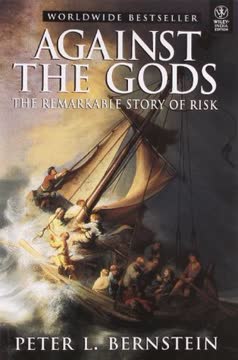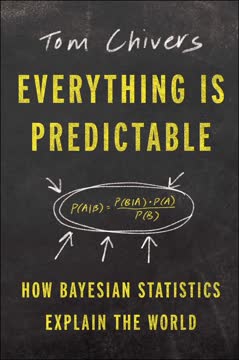Key Takeaways
1. The Critical State: A Universal Pattern of Instability
"The critical state seems to exist in all kinds of things regardless of what they are made of, and what elements of physics go into their description."
Universal phenomenon. The critical state is a fundamental organizing principle found in diverse systems, from physical to biological and social. It represents a delicate balance between order and chaos, where small events can trigger large-scale changes.
Characteristics of criticality:
- Poised between stability and instability
- Exhibits scale-invariant behavior
- Produces power law distributions
- Demonstrates sudden, unpredictable changes
This concept challenges traditional views of causality and predictability in complex systems, suggesting that many phenomena we observe in nature and society may share underlying similarities in their dynamics.
2. Self-Organized Criticality: The Sandpile Model
"Bak, Tang, and Weisenfeld had found a far-from-equilibrium game for earthquakes, all right, and it was simply the old sandpile game in disguise."
Simple model, complex behavior. The sandpile model, introduced by Per Bak and colleagues, demonstrates how complex systems can naturally evolve to a critical state without external tuning. This self-organized criticality explains the emergence of similar patterns across diverse fields.
Key aspects of the sandpile model:
- Gradual addition of grains (energy or stress)
- Local threshold rules for avalanches
- Power law distribution of avalanche sizes
- Finger-like structures of instability
The model's simplicity and wide applicability make it a powerful tool for understanding critical phenomena in fields ranging from geophysics to economics and social sciences.
3. Earthquakes and Forest Fires: Natural Critical Systems
"Earthquakes in the real world tend to be accompanied by foreshocks and aftershocks, which is another way of saying that large earthquakes tend to cluster together in time, and that the longer you wait without seeing one, the longer you will probably have to wait."
Nature's critical events. Earthquakes and forest fires exemplify critical phenomena in natural systems. Both exhibit power law distributions in their sizes and frequencies, indicating an underlying critical state organization.
Common features of earthquakes and forest fires:
- Long periods of apparent stability
- Sudden, large-scale events
- Difficulty in predicting individual occurrences
- Cluster in time and space
Understanding these systems as critical phenomena challenges traditional approaches to prediction and management, suggesting that large events are intrinsic to the system rather than anomalies.
4. Mass Extinctions: Evolution's Critical State
"The power-law perspective hints that the mass extinctions may not be exceptions to the workings of evolution. Rather than the fingerprints of the Hand of God reaching in from afar, they may be the inevitable product of evolution's most ordinary principles."
Evolution's upheavals. Mass extinctions, long viewed as exceptional events caused by external factors, may instead be natural outcomes of the evolutionary process itself. This perspective suggests that the biosphere operates in a critical state, prone to large-scale fluctuations.
Implications of critical state evolution:
- No fundamental difference between background and mass extinctions
- Interconnectedness of species in ecosystems
- Inevitability of large-scale evolutionary changes
- Challenges to traditional views of evolutionary stability
This critical state view of evolution provides a unified framework for understanding both gradual and rapid changes in the history of life on Earth.
5. Financial Markets: Critical Fluctuations in Economics
"In conflict with our intuition, even these are merely business as usual. Scientists sometimes refer to power-law distributions as having 'fat tails,' because in comparison to the ends of a bell curve, the tails of a power-law curve don't fall off so quickly."
Market volatility explained. Financial markets exhibit characteristics of critical systems, with price fluctuations following power law distributions. This challenges traditional economic theories that assume markets are efficient and in equilibrium.
Features of critical financial markets:
- Large price swings are more common than expected
- Market crashes are intrinsic, not anomalous
- Herd behavior and information cascades
- Limitations of risk management based on normal distributions
Understanding markets as critical systems has profound implications for economic policy, risk management, and investment strategies.
6. Scientific Revolutions: Critical State in Knowledge Evolution
"Even for momentous events such as world wars, historians may ultimately be able to do little more than point to origins in a nose or a monkey bite, or to the automobile driver who made a wrong turn, and then trace the chain of events that followed."
Knowledge at the edge. Scientific progress occurs through a combination of gradual accumulation and sudden, revolutionary changes. This pattern mirrors the behavior of critical systems, with the network of scientific ideas poised at the edge of instability.
Characteristics of scientific revolutions:
- Periods of normal science punctuated by paradigm shifts
- Power law distribution of citation impacts
- Unpredictability of which ideas will trigger revolutions
- Interconnectedness of scientific concepts
This perspective on scientific progress emphasizes the role of contingency and the potential for small ideas to have outsized impacts on the development of knowledge.
7. The Power Law: Signature of Criticality in Complex Systems
"The power law simply reflects this situation, and points to the riddling instability that underlies the sandpile's workings."
Mathematical fingerprint. Power laws are ubiquitous in critical systems, appearing in phenomena as diverse as earthquake magnitudes, city sizes, and wealth distribution. They indicate scale-invariance and the absence of a characteristic size for events or entities in the system.
Key aspects of power laws:
- Linear relationship on log-log plots
- No typical or average event size
- Self-similarity across scales
- Indicative of underlying critical dynamics
The prevalence of power laws across diverse fields suggests a deep commonality in the organization of complex systems, from physical to social and economic.
8. Human History: A Critical State of Unpredictable Change
"If the world is critical, then there are local causes that can be investigated, and we can make sense of how politics and social forces shape historical changes here and there. But if the ultimate effects of any happening depend on how the details link together to create 'fingers of instability' stretching through the world, it becomes virtually impossible to see into the future."
History's critical dynamics. Human history may be understood as a critical system, characterized by periods of relative stability punctuated by sudden, large-scale changes. This view challenges both deterministic and purely random interpretations of historical processes.
Implications for historical analysis:
- Importance of contingency and small events
- Limitations of predictive historical models
- Interconnectedness of social, economic, and political factors
- Reconsideration of the role of "great individuals" in history
This critical state perspective on history emphasizes the inherent unpredictability of historical processes while still allowing for meaningful analysis of local causes and effects.
9. The Limits of Prediction in Critical Systems
"Predicting the long-term future of any chaotic system is practically impossible, and a chaotic process looks wildly erratic even if the underlying rules are actually quite simple."
Fundamental unpredictability. Critical systems, while governed by simple underlying rules, exhibit behavior that is inherently difficult to predict. This limitation applies across various fields, from earthquake forecasting to economic predictions and historical prognostication.
Challenges in predicting critical systems:
- Sensitivity to initial conditions (butterfly effect)
- Long-range correlations and interdependencies
- Possibility of large events at any time
- Limitations of statistical forecasting
Recognizing these limits can lead to more robust approaches to risk management, policy-making, and scientific inquiry that acknowledge inherent uncertainties.
10. Great Events from Small Causes: The Butterfly Effect in History
"Cleopatra's nose, had it been shorter, the whole face of the world would have changed."
Cascading consequences. In critical systems, seemingly insignificant events can trigger large-scale changes through cascading effects. This "butterfly effect" is observed in various domains, from weather systems to historical events.
Examples of small causes with large effects:
- Assassination of Archduke Franz Ferdinand triggering World War I
- Discovery of penicillin from a contaminated petri dish
- Invention of the World Wide Web as a side project at CERN
Understanding history through this lens emphasizes the role of contingency and the potential for small actions to have profound, unforeseen consequences. It challenges simplistic notions of historical inevitability and highlights the complexity of causal relationships in human affairs.
Last updated:
FAQ
1. What is Ubiquity: Why Catastrophes Happen by Mark Buchanan about?
- Exploring unpredictability in history: The book investigates why both human history and natural phenomena are marked by sudden, dramatic upheavals—such as wars, earthquakes, and market crashes—that defy traditional prediction.
- Critical state as a central idea: Buchanan introduces the concept of the "critical state," a condition in which complex systems are poised on the edge of instability, making them susceptible to large-scale events triggered by small disturbances.
- Bridging disciplines: Drawing from physics, history, economics, and ecology, the book provides a new framework for understanding why catastrophes are common and follow universal patterns across diverse systems.
2. Why should I read Ubiquity: Why Catastrophes Happen by Mark Buchanan?
- New perspective on disasters: The book offers a scientific lens to view unpredictable disasters, challenging traditional cause-and-effect explanations by revealing underlying universal patterns.
- Interdisciplinary insights: Buchanan connects ideas from physics, ecology, economics, and history, helping readers appreciate the interconnectedness of natural and social phenomena.
- Understanding inevitability: Readers learn why upheavals are not anomalies but expected outcomes in complex systems, providing a deeper understanding of the world’s inherent unpredictability.
3. What are the key takeaways and implications of Ubiquity for understanding complex systems?
- Balance of order and chaos: Systems at criticality are delicately balanced, where small events can cause large, unpredictable changes, explaining the ubiquity of catastrophes.
- Universality and simplicity: Despite complexity, many systems share universal behaviors governed by simple mathematical laws, allowing insights from physics to illuminate economics, history, and social science.
- Limits of prediction and control: The critical state implies inherent unpredictability in large-scale events, cautioning against overconfidence in forecasting or controlling complex systems like markets or societies.
4. What is the "critical state" in Ubiquity and why is it important?
- Definition of critical state: A critical state is a condition where a system is balanced between order and chaos, hypersensitive to small disturbances that can trigger events of any size.
- Power-law behavior: Systems in a critical state exhibit power-law distributions, meaning there is no typical event size; both small and large fluctuations follow the same statistical pattern.
- Implications for prediction: This hypersensitivity and scale invariance make predicting the exact timing or size of catastrophes nearly impossible, but understanding the critical state explains why such events are inevitable.
5. How does Mark Buchanan’s sandpile model illustrate the critical state in Ubiquity?
- Simple model of complexity: The sandpile game involves dropping grains of sand onto a pile, which grows until avalanches occur unpredictably, modeling how systems self-organize into a critical state.
- No typical avalanche size: Avalanches in the sandpile follow a power law, with both small and large events occurring in predictable frequency ratios, reflecting scale-invariance.
- Analogy for real-world systems: The sandpile serves as a metaphor for phenomena like earthquakes, forest fires, and market crashes, where critical organization leads to sudden, unpredictable upheavals.
6. What is self-organized criticality in Ubiquity and how does it differ from tuned criticality?
- Definition of self-organized criticality: This is when systems naturally evolve to a critical state without external tuning, as seen in the sandpile model with slow grain addition.
- Limitations and need for tuning: True self-organized criticality requires specific conditions, such as slow driving and certain properties; real systems often need some parameter adjustment to reach criticality.
- Implications for natural systems: Many natural systems appear roughly tuned to criticality, explaining the widespread occurrence of power laws and unpredictable upheavals across disciplines.
7. How does Ubiquity explain the universality of power laws across different systems?
- Universality classes: Systems with different components (atoms, people, companies) can belong to the same universality class if they share key features like spatial dimension and interaction topology.
- Irrelevance of details: Many microscopic details do not affect critical behavior; instead, geometry and the logic of interactions are what matter.
- Examples across disciplines: This universality explains why power laws appear in earthquakes, magnets, financial markets, city sizes, and scientific revolutions, revealing a common mathematical structure.
8. How does Ubiquity by Mark Buchanan address the predictability of earthquakes and other natural disasters?
- Prediction remains elusive: Despite technological advances, reliable prediction of earthquakes has proven impossible, as no consistent precursors or cycles have been found.
- Critical state avalanches: Earthquakes are explained as avalanches in the Earth's crust's critical state, where tiny slips can cascade unpredictably.
- Power law distribution: Earthquake magnitudes follow a power law, indicating that both large and small quakes arise from the same underlying process, with no special cause for big events.
9. What does Ubiquity by Mark Buchanan reveal about economic markets and financial crashes?
- Markets as critical systems: Financial markets operate in a critical state, where price changes follow power laws with "fat tails," making large crashes expected rather than exceptional.
- Limitations of traditional economics: The book critiques mainstream models for failing to predict crashes, showing that wild fluctuations arise naturally from traders' interactions.
- Role of collective psychology: Models that include traders’ moods and mutual influence reproduce real market statistics, suggesting that network effects and collective behavior drive volatility.
10. How does Ubiquity relate to the patterns of human history, wars, and revolutions?
- Power laws in wars: Evidence shows that wars follow power-law distributions in size, implying no typical war and that large wars are natural outcomes of a critical social state.
- Thresholds and contagion: Social or political stress can build to a threshold, leading to sudden breakdowns and cascading effects, much like avalanches or forest fires.
- Network effects: Conflicts and revolutions spread through networks of influence, where one event can trigger widespread change without a unique or exceptional cause.
11. What does Ubiquity by Mark Buchanan say about the "great person" theory of history?
- Critique of great person theory: While individuals can influence history, the critical state suggests that many events arise from systemic organization rather than solely from exceptional people.
- Great grains analogy: Any individual can have outsized impact if they act at the right moment in a critical system, not necessarily due to personal greatness.
- Collective forces over individuals: History is shaped more by collective social dynamics and network effects than by the actions of isolated "great men," aligning with modern historical analysis.
12. How does Ubiquity by Mark Buchanan use the concept of small-world networks to explain social and economic phenomena?
- Definition of small-world networks: These networks are highly clustered locally but also have a few long-range connections, drastically reducing the average path length between nodes.
- Social connectivity: Human social networks, such as friendships or professional ties, exhibit small-world properties, explaining phenomena like "six degrees of separation."
- Amplifying critical effects: Small-world networks facilitate rapid and widespread propagation of ideas, emotions, or economic behaviors, amplifying the effects of the critical state in social and financial systems.
Review Summary
Ubiquity receives mostly positive reviews for its exploration of complexity theory and power laws across various systems. Readers appreciate Buchanan's accessible writing and thought-provoking ideas, though some find the later chapters repetitive or unconvincing. The book is praised for its insights into unpredictability, self-organized criticality, and the similarities between natural and human-made systems. Many reviewers draw connections to other popular science books and find the concepts applicable to understanding historical events and everyday phenomena.
Similar Books










Download PDF
Download EPUB
.epub digital book format is ideal for reading ebooks on phones, tablets, and e-readers.







